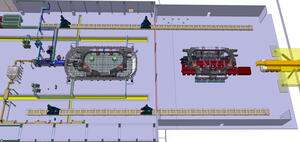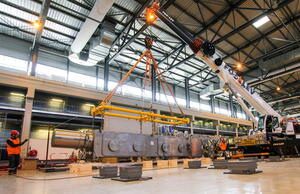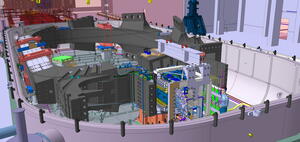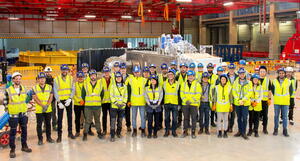On the fast track to operation
The project to build a cold test facility for the ITER magnets is bringing together experts from across ITER, as they race to seize a golden opportunity to test magnets and associated systems at 4 K (minus 269 °C).
As development of the 2024 ITER baseline was underway, it became apparent that the revised schedule for machine assembly would allow for time to conduct valuable cold testing on some of the tokamak’s D-shaped toroidal field coils, as well as the smallest poloidal field coil (PF1) and other key systems required for magnet operation. But there was one catch: the window of opportunity was so small that the testing project would have to advance at double speed.'
To achieve this goal, the magnet cold test facility project was launched in June 2023 and a matrixed team from different units of ITER was quickly established to fast-track design, procurement, manufacturing, and installation. Now, major design and procurement milestones are being reached for this project-within-a-project and the facility is on pace for initial commissioning to begin this summer, leading to the installation receiving its first magnet for 4 K testing by the end of the year.
“In a little more than a year and a half—less than half the ‘normal time’ an operation like this would usually take—we’ve gone from nothing to a design that is essentially finalized, equipment either delivered or in manufacturing, and installation works underway,” says Karim El Hamdani, the project leader for the test facility. “We’re meeting these challenges because everybody was very agile at ITER, and we were able to set up a multidisciplinary team including magnet, cryogenics, electrical, instrumentation, control, vacuum, building, and procurement specialists. Because this was a priority, everyone had a clear goal with very, very tight deadlines.”
Located in the former Poloidal Field Coils Winding Facility, the cold test facility will have its own cryostat and power system to cool magnets to 4 K (minus 269 °C) and energize them up to 68 kA—offering a real-scale test of a diverse set of toroidal field coils, from multiple coil and conductor manufacturers, as well as a general rehearsal for auxiliary systems (feeders, cryogenics, control-command…) to derisk that portion of integrated commissioning.
In 2024, test facility design was finalized in collaboration with a panel of international experts. With most of the components now completed and at ITER, the facility is moving rapidly to the commissioning phase thanks to progress being made on parallel fronts:
- Cryostat – A 330-tonne customized cryostat (10.5 m x 21.2 m x 6 m) is in fabrication and the overall manufacturing progress is near 75%.
- Power supply system – A customized 68 kA power supply system is in fabrication and overall manufacturing progress is near 95%. Final factory acceptance tests are proceeding.
- Cryogenics, vacuum system – The valve box, the cryo and auxiliary lines, and the required vacuum pumps, valves, and baffles are nearing manufacturing completion, while simulations have been run for the cool-down and warm-up of toroidal field magnets.
- Building – Some requalification activities are underway to adapt the former winding facility to the needs of the test facility: for example, the gantry crane must be adapted to lift toroidal field coils (testing is planned in May with a first toroidal field coil trial lift).
- Feeder – In another sub-project, feeder components that will eventually be used in the tokamak have been delivered for testing. Because the toroidal coils will be tested horizontally instead of in their ultimate vertical position, a customized interface, the in-cryostat feeder, is being manufactured, with delivery expected in late June.
- Instrumentation – Software for quench detection is practically completed and manufacturing is underway or finalized for high- and low-voltage cables and devices.
- Control – Design of the central control system is almost completed, software development is in progress, and the control cabinets are being manufactured.
- Facility scope – The matrixed team that completed the assessment of facility requirements/design, supporting analysis (structural, thermohydraulic, magnet protection), and test plans will also be mobilized during facility commissioning and operation. Experts from the European Domestic Agency Fusion for Energy joined for the design and procurement phase to accelerate the process.
“This project has already achieved success as it has brought all the specialists required to operate the magnet system together to achieve a challenging and motivating short-term goal,” says Thierry Schild, who is overseeing the technical aspects of the test facility. “We’ve already identified many interfacing and operating questions to be answered during facility operation, which will be very precious know-how for machine commissioning.”
While the installation activities are ramping up, the magnet cold test facility will be connected to the cryoplant before the summer and commissioning tests without the cryostat are scheduled to begin in July. Once the cryostat arrives in September and is installed, preparations will begin for the testing of the first toroidal field coil. The facility is expected to operate for several years, with approximately four to six months required per magnet.





